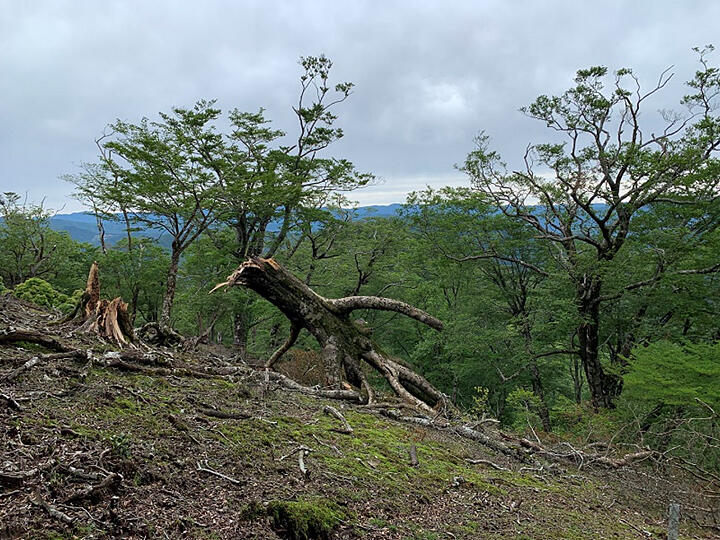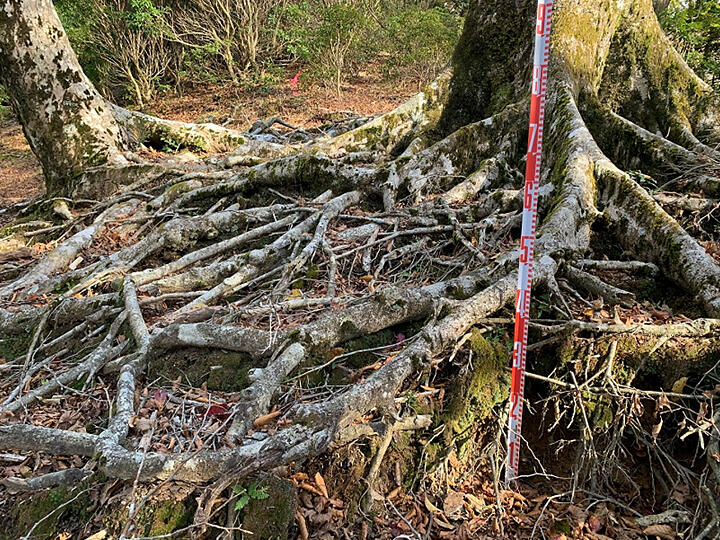The beech forests in the southern part of Kyushu have been declining owing to soil erosion caused by the increasing number of deer. This report was made by the research group of Graduate Student Hayato Abe of the Graduate School of Bioresource and Bioenvironmental Sciences, and Assistant Professor Ayumi Katayama of the School of Agriculture at Kyushu University, together with Professor Fujio Hyodo of the Graduate School of Environmental, Life, Natural Science and Technology, Okayama University, and other collaborators. The discovery was made when the group investigated the relationship between soil erosion and tree growth in beech forests where the numbers of deer have been increasing. The findings are expected to be useful for the development of forest preservation measures. The research results were published in the October 11 issue of the international academic journal Catena.

Provided by Kyushu University
A large number of beech forests in the mountain areas of the southern part of Kyushu that lie within the western and southern limits of the natural habitat of Japanese beeches have been designated as forest preserves because of the valuable genetic features of the Japanese beech tree (Fagus crenata). However, the number of deer has been increasing in many of these areas, causing a decrease the amount of understory vegetation. Previous reports have indicated that the trees in some areas of those beech forests are withering, dying, and losing foliage. However, it remained unclear how the increasing number of deer and decreasing understory vegetation were related to the declining beech forests.

Provided by Kyushu University
The research group investigated the Shiiba Research Forest (Shiiba Village, Higashi-Usuki District, Miyazaki Prefecture) of the Faculty of Agriculture of Kyushu University and ascertained the possibility of the exposed roots being one of the factors for the suppression of beech tree growth.
The research forest has been observed continuously for a long period of time, and the number of deer within has been counted. The deer number started to increase in the 1980s. Moreover, soil erosion was observed in the forest area that lost understory vegetation. Because it had been eaten by the deer, the understory vegetation was lost before 2003, which resulted in the tree roots being exposed on the soil surface.
The research group investigated 12 individual beech trees near the top of Mt. Sanpo, where the research forest is located. They measured the height from the top of the exposed roots to the soil surface as an index of soil erosion around each of the beech trees. They also measured the amount of foliage produced on each tree, the degree of trunk growth, and the number of fine roots. Subsequently, they evaluated the relationship between the number of exposed roots and each of these measurements. The tree individuals selected for this study were almost at the same altitude and generally of the same size, but they had different amounts of exposed roots. The research group found that the trees with a large number of exposed roots produced a small amount of foliage, and their trunks have not exhibited much growth. Furthermore, the greater the amount of soil erosion, the less tree growth there was above the soil surface.
Next, the research group collected stem core samples from each beech tree to analyze the widths of the annual rings in temporal sequence. The growth of beech tree individuals that showed a low growth rate has been declining from year 1997.6 ± 9.0. This agreed with the time of decrease or loss of the understory vegetation in this area.
To reveal the underlying mechanism of this phenomenon, the research group focused on the effects of water and nitrogen shortage by investigating the soil environment and physiological condition of the beech trees. Thus, they analyzed the water use efficiency (an index of the degree of water stress) of the beech trees, which was calculated from the stable carbon isotope of core samples with annual rings. As a result, they found that the low growth rate of these beech trees could possibly be caused by water stress. They found that the deer's strong appetite for plants had possibly caused the soil erosion, which suppressed the growth of the beech trees. This meant that the number of leaves and branches that should have covered the soil surface had decreased, and further soil erosion could go on to form a negative spiral. Although this study covered only the southern part of Kyushu, it is possible that similar forest degradation may be occurring throughout Japan. It is noteworthy that the eating habits of deer differ from region to region, and it is said that the deer in Kyushu do not eat bark, including beech bark.
Abe stated, "Our research has revealed that the deer's strong appetite for plants has been accelerating the degradation of beech trees. Protective barriers are being installed all over the country to prevent deer from eating plants. We are currently advancing our research to verify if such control management practices are effective in reducing the foraging pressure from deer. We hope that such knowledge will be useful for promoting cohabitation with deer."
Journal Information
Publication: Catena
Title: Soil erosion under forest hampers beech growth: Impacts of understory vegetation degradation by sika deer
DOI: 10.1016/j.catena.2023.107559
This article has been translated by JST with permission from The Science News Ltd. (https://sci-news.co.jp/). Unauthorized reproduction of the article and photographs is prohibited.




